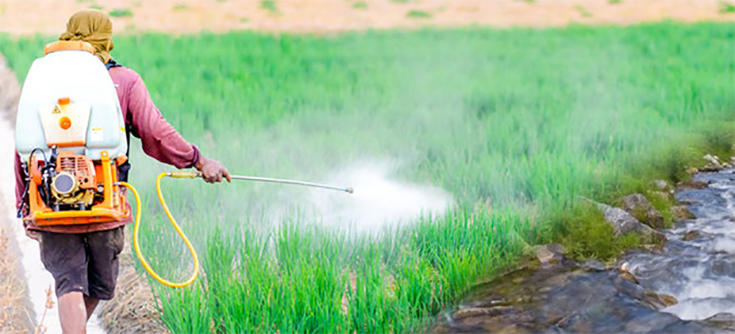Even Legal Levels of Glyphosate Herbicide may Harm Freshwater Ecosystems
Even Legal Levels of Glyphosate Herbicide may Harm Freshwater Ecosystems
Glyphosate + other ingredients harmful than just glyphosate
Glyphosate, a controversial ingredient found in Monsanto’s Roundup herbicide, is showing up in streams, rivers, and other aquatic systems around the world due to runoff.
Glyphosate, a controversial ingredient found in Monsanto’s Roundup herbicide, is showing up in streams, rivers, and other aquatic systems around the world due to runoff. Unfortunately, this may be damaging a type of green macroalgae that is common in streams, a new Brazilian study published in the journal Phycologia shows. [1]
Researchers say the macroalgae is sensitive to glyphosate exposure, even at legal levels , which was something they had anticipated. They found that glyphosate can alter the macroalgae’s photosynthesis, chlorophyll levels, and respiration . [1]
Professor David Garbary, the Editor of Phycologia , says:
“This paper provides an important contribution to our knowledge of the environmental toxicology of glyphosate-based herbicides in freshwater aquatic systems.”
Glyphosate-containing herbicides are among the most commonly used weedkillers in the world. Several studies have found glyphosate contamination in U.S., Canadian, French, Argentinean, and other waters. Until now, however, no research had been done on the effects of these herbicides on macroalgae.
Nearly 188,000 tons of glyphosate was sold in Brazil in 2013 alone. [2]
Read: Glyphosate is a major contributor to Water Pollution
Macroalgae are the perfect measuring sticks for the health and clarity of rapidly moving fresh water . They are vitally important organisms in streams, where they cycle nutrients and increase plankton .
The Study
For the new study, researchers tested several concentrations of technical-grade glyphosate, Roundup, and aminomethylphosphonic acid (AMPA) to determine the type of impact they have on Nitella microcarpa var. wrightii, a green algae found worldwide. Samples were collected from a stream in southwestern Brazil.
AMPA is the main degradation product of glyphosate.
The team found that Roundup and its surfactants greatly reduced algal photosynthesis . Study author Ciro Cesar Zanini Branco explained:
“Such effects are related to the concentration of the active ingredient and also to the exposure time. These impacts were observed even at the concentration levels allowed by Brazilian regulations.”
AMPA, on the other hand, increased photosynthesis. Additionally, AMPA treatment increased dark respiration (respiration that occurs regardless of light). And when AMPA and certain amounts of glyphosate alone were applied together , less chlorophyll was produced.
Read: Glyphosate Threatens Ocean Life Coral Reefs
Sustainable Pulse said in a press release
“Clearly, the performance of the algae was affected by the herbicides. It seems that the form of the herbicide (glyphosate, glyphosate plus surfactants – Roundup, or AMPA) is crucial in determining the intensity of the effects, which means that algal productivity could shift visibly depending on the types of herbicides applied to agricultural land near a stream—even if farmers are using them legally.”
Dr. Nathan Donley, a scientist at the Center for Biological Diversity, says that the study proves “that glyphosate in combination with other ingredients can be more harmful than just glyphosate by itself.” He goes on:
“A lot of the recent focus on glyphosate has been on human cancer, but it’s important to realize that this is not only a carcinogen but also a toxin that is harmful to our natural ecosystems. [2]
Glyphosate is extremely toxic to plant life and these effects can have serious consequences for other organisms as well. We’ve been seeing glyphosate killing milkweed all over the country and having serious unintended consequences for the Monarch butterfly. It is still unknown how these effects on macroalgae could be effecting changes in stream ecosystems.
The problem is that the [Environmental Protection Agency] is still stuck in this fairytale world where chemicals are encountered in isolation and that is not an accurate reflection of how exposure occurs. ‘Inert’ ingredients are not inert, they have activity and they can change the toxicity profile of the active ingredients and can also have toxicities themselves.”
| About Julie Fidler: | |
| Julie Fidler is a freelance writer, legal blogger, and the author of Adventures in Holy Matrimony: For Better or the Absolute Worst. She lives in Pennsylvania with her husband and two ridiculously spoiled cats. She occasionally pontificates onher blog. | |
Other Popular Stories:

Post a Comment